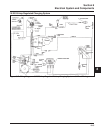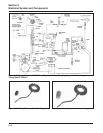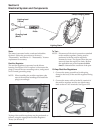
8.22
Section 8
Electrical System and Components
Problem Test Conclusion
1. Trace B+ lead from rectifier-
regulator to key switch, or other
accessible connection. Disconnect it
from switch or connection. Connect
an ammeter from loose end of B+
lead to positive terminal of battery.
Connect DC voltmeter from loose
end of B+ lead to negative terminal
of battery. With engine running at
3600 RPM, read voltage on
voltmeter.
If voltage is 13.8 volts or more,
place a minimum load of 5 amps*
on battery to reduce voltage.
Observe ammeter.
*NOTE: Turn on lights, if 60 watts
or more. Or place a 2.5
1. If voltage is 13.8-14.7 and charge rate increases when
load is applied, the charging system is OK and battery
was fully charged.
If voltage is less than 13.8 or charge rate does not
increase when load is applied, test stator (Tests 2 and 3).
If the voltage is low and does not increase, and there is
no charging/amperage output, disconnect and reconnect
the rectifier-regulator plug and retest.
a. If the ammeter shows charge for a short time but
then drops back to zero, the rectifier-regulator is
functioning correctly but the battery is faulty. Replace
the battery.
b. If no amperage/charge rate appears during the
retest, go to step 2.
Troubleshooting Guide
15/20/25 Amp Battery Charging Systems
When problems occur in keeping the battery charged or the battery charges at too high a rate, the problem can
usually be found somewhere in the charging system or with the battery.
NOTE: Always zero ohmmeter on each scale before testing to ensure accurate readings. Voltage tests should
be made with the engine running at 3600 RPM - no load. The battery must be good and fully charged.
2. Remove connector from rectifier-
regulator. With engine running at
3600 RPM, measure AC voltage
across stator leads using an AC
voltmeter.
2. If voltage is 28 volts or more, stator is OK. Rectifier-
regulator is faulty. Replace the rectifier-regulator.
If voltage is less than 28 volts, stator is probably faulty
and should be replaced. Test stator further using an
ohmmeter (Test 3).
No Charge
to Battery
3a. With engine stopped, measure the
resistance across stator leads using
an ohmmeter.
3a. If resistance is 0.064/0.2 ohms, the stator is OK.
If the resistance is infinity ohms, stator is open. Replace
stator.
3b. With the engine stopped, measure
the resistance from each stator lead
to ground using an ohmmeter.
3b. If the resistance is infinity ohms (no continuity), the
stator is OK (not shorted to ground).
If resistance (or continuity) is measured, the stator leads
are shorted to ground. Replace stator.
1. If the voltage is 14.7 volts or less the charging system is
OK. The battery is unable to hold a charge. Service
battery or replace as necessary.
If voltage is more than 14.7 volts, the rectifier-regulator is
faulty. Replace rectifier-regulator.
1. Perform same test as step 1 above.
Battery
Continuously
Charges at
High Rate


















